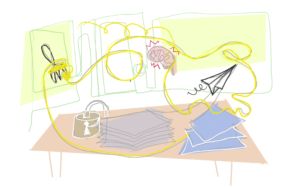In September 2021, the BMJ has published the article “To improve quality, leverage design “ by Crowe B, Gaulton JS, Minor N, et al comparing QI methodologies to design thinking and suggesting the integration of both approaches to make improvement more human centered. and thus, bringing the best of both worlds.
For a long time in my career, I had the honor to work in the trenches with hospital teams on several quality improvement initiatives, sometimes as a member, and other times as a coach and facilitator. We have experimented with a number of improvement methodologies, for which the Model for Improvement (MFI) had the biggest traction for good reasons. First, it’s based on the science of improvement and was developed by experts in the field. Second, it didn’t require an entirely new mindset or technical skills for clinical teams to understand and implement. Last but not least, it was proven to be successful across many healthcare organizations world-wide. Nevertheless, every approach has its limitations and may not suit all types of problems to solve.
Over many years now, I’ve been dabbling with the application of design thinking in healthcare, and I do believe that it could provide more and different answers to many problems, both on a tactical care delivery level, and on a strategic system-level, and for good reasons too.
Humans in mind:
As we all know, it can’t get more human than healthcare. We deal with physical and mental challenges both immediate and longterm, trying to improve the quality of lives from people’s perspective, while accounting for individual and population needs.
Many improvement methodologies are developed by scientists to solve issues on the technical side of care, and primarily from the point of view of the practitioner.
Design thinking is human-centered by default, so patient-centered care as one of the main aims of healthcare quality, is already embedded in the process. Empathy with humans is at the heart of any design thinking effort with great emphasis and more space for user research and engagement, in this case patients, their families, and the community at large. This all happens upfront before even consenting on the problem to tackle, and continues throughout the multiple phases until reaching the best possible answer.
Uncertainty at its highest:
One of the attributes of design thinking is the iterative nature of trying multiple versions at every step. In the early stages of discovery, design teams spend considerable amount of time and energy to deeply understand the situation and usually reaching a different conclusion about the problem at hand. This convoluted way of framing and reframing of problems doesn’t come naturally to most of us, let alone healthcare professionals who are usually eager to zero in on one issue based on some facts and many assumptions, then go down a linear path to come up with solutions. Even repetitive PDSA testing cycles, for example, are short of the rigor and the open-endedness of iterations and experimentation embraced by design thinkers. I can vividly remember how the multidisciplinary care teams felt uncomfortable to spend the first few hours of any improvement project in dissecting the problem by uncovering root causes deeper and looking at it from all angles possible, before using their brain power to plan and execute ideas they are excited about and perhaps discover months or even years later that they had it figured out wrong. This heavy investment on the front end of discovery and deep understanding is a basic principle of good design compared to traditional improvement methods.
Thinking with your hands:
Prototyping, or creating a tangible form of your ideas to solve the problem is a “biggie” in design thinking. It’s not only about the tools or materials to be used, but it underlies the unique mentality and attitude of the design thinker, with enough time spent on showing the users the idea to test and receive feedback, rather than talking about it, or jumping into testing with an almost final solution.
In the model for improvement, this is less obvious with PDSA testing cycles conducted using final or semi-final version of the solution which, if failed, entails loss of precious time, effort, and resources.
Dealing with complexity:
Many of the widely used methods to improve quality of care usually follow a linear straightforward path where teams believe they know the problem, and perhaps have a hint of the solution if not already decided from the get go, as one American Intensivist described it as “one dimensional” approach to problem solving. The aim is usually very specific in the name of focus and clarity. That’s all great and efficient if all problems we are dealing with are simple to define.
In such a complex system like healthcare, problems are usually multifaceted and multidimensional. Therefore, choosing a linear approach would usually risk missing other important aspects of the problem leading to suboptimization, if not worsening the same situation they have started with. Even if multiple pilots are run in parallel to find the best combination of changes, they are still based on a narrow and often hasted definition of the problem.
For the past few years, I’ve been involved in a strategic level work of healthcare quality, and I could see with no doubt the complexity of change needed, the uncertainty of the path forward, the ambiguity of the challenges the healthcare system is facing and will continue to, and the fact that most of us are not well equipped to make the right decisions amid all that chaos.
This manifestation of “wicked” problems, as they are sometimes called, are better addressed using an approach robust enough to uncover multiple hidden needs and issues, and rely on experimentation and learning from fast and low risk failures to reach better conclusions at the end.
By having a quick look at both methodologies, the model based on the science of improvement feels a bit more, well, scientific, and formal. On the other hand, design thinking lends itself as a more flexible, forgiving, and definitely more fun approach. Perhaps this is why design thinking might be a superior way for problem solving and improvement, especially at this day and age, where creativity and agility are more valued than conventional wisdom.




